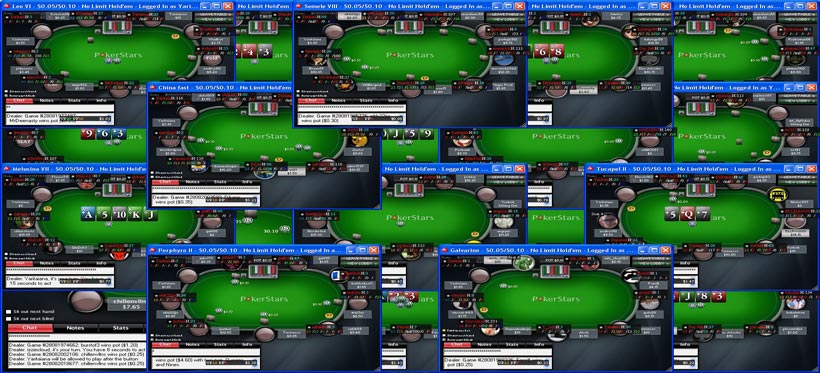How does rakeback work? This article will explain how some pros make a living off of playing so much volume that their income is based on rakeback percent.

In order to understand exactly 'how does rakeback work' we need to take a step back and explain how poker rooms make their money. When it comes to cash games the company that's kindly providing you with the ability to play online poker using their software takes some percentage of every pot for their trouble. Usually, it's in the neighborhood of 5%, but each poker room has different rules and regulations when it comes to this matter.
Tournament players aren't free of the rake either. If you've ever wondered why SNG and MTT buy-ins often look like this: 10$+1$, 2$+0.2$ the answer to this question is simple and it starts with the letter "R". If you think 5-10% rake doesn't seem like a big deal
I assure you that it is. The existence of the rake is one of the main reasons why only the top 10-15% of
players can be winners at poker. Imagine the scenario where you and 5 other people bring a giant box of toy cars to the table, dump it all in the middle and try to get back as many of the other player's toy cars while protecting your own. At the same time, the owner of the table is taking one small toy car from the table every minute. Given enough time, there will be no toy cars left to play with.
Weighted Contributed Rakeback
Ok, but how many toy cars... I mean how much rake is the poker room is taking from me?

The answer to this question used to be slightly more complicated a couple of years ago, but nowadays
the weighted contributed method of calculating rake has become the industry standard. Here's a quick explanation of how this method works:
In the weighted contributed calculation method, every player is credited rake based on the percentage of money that he or she contributed to the pot. Let's say that at a 6-max table, half of the players fold and half of them decides to see the flop by paying 1$. One of the players goes all-in on the flop for another 3.5$, the next one folds and the last player decides to call the 3.5$ all in making the entire pot worth 10$. Poker room then takes 5% (0.5$) from the pot as rake. In the above example the first and the last player would be credited with 45% of the rake each (45% of 0.5$ being 0.225$) and the last one would be credited with the remaining 10% (0.05$) since he only invested 1$ into the pot (10% of the final pot's value).
Rakeback

Many poker rooms graciously offer to give you back some of the rake that they took from you in the form of a rakeback. Rakeback, can take many different forms, but it's essentially - as the name suggest -
the portion of the rake that poker room periodically (usually once a month, once a week or per your request) transfers back into your account.Percentage based rakeback deals used to be by far the most popular with
30% being an industry standard. Nowadays, this can be a lot more complicated which we'll get into in a moment but you can still find
a bunch of flat rakeback offers using PokerVIP deals on
Microgaming,Ipoker and many other different networks.
A Rakeback By Any Other Name?

As we've already mentioned before,
flat percentage is not the only form of rakeback available. In fact, some of the poker rooms with amazing deals don't offer the percentage based rakeback at all, instead opting for a VIP program based on points, deposit bonuses or frequent reload bonuses. Fortunately, this can be easily represented in the form of a percentage and
you'll notice that PokerVIP usually does this job for you if you browse our deals.For example,
Unibet VIP program can add up to 60% rakeback based on your volume and if you
take a look at our William Hill deal you'll notice that
the first 25 euro of deposit bonus clears at a rate of 50% with the rest adding a cool 10% rakeback to the already attractive deal. All in all, if you know basic math and adjust it for some factors like the volume,
you can easily figure out the rakeback % you're going to get no matter how certain poker room chooses to structure their VIP program.
The last (and particularly important point, given that you're reading a PokerVIP article!)
source of rakeback can come in a form of an affiliate rake race.
Our Top500 Race (along with some room specific promotions that we're offering on
StanJames,
Betfair,
BetVictor, and
Intertops)
represents an amazing value that you can take advantage of as a PokerVIP member. You just have to register and play on one of the eligible poker rooms using one of the links
in the Deal section of our site.Rakeback as a Part of Your Strategy

Here are some key points when using rakeback as part of a profitable strategy...
- Pay attention to the big picture. 50% rakeback doesn't have to be a better choice than 30%. The absolute % means very little if we don't compare it with the rake that we're paying. For example, if you end up paying 20bb/100 in rake on a poker room A with 50% rakeback deal you're in a relatively worse situation than you'd be playing on a poker room B charging you 10bb/100 on average and awarding with 30% rakeback. In the first example, you're effectively paying 10bb/100 in rake and in the second one only 7bb/100. The situation gets even more complicated if we start adjusting our calculations for some external factors, like the quality of the games or poker room traffic.
- Variance free money. Many professional players choose to treat their rakeback as a regular pay-day. Assuming your bankroll management strategy and skill are good enough to greatly minimize the risk of dropping to a lower limit, and you're disciplined enough to maintain the same volume each month, poker that's unstable in nature can reward you with a consistent amount of money each month. You can also opt to use the rakeback money to soften the blow of a downswing.
- Avoid the rakeback grinder trap. Grinding for rakeback can be very profitable in some cases but it can also lead to some issues if you choose to make it your long-term strategy. Since poker win rates are so hard to calculate, if you're aiming to maximize rakeback and maintain a 0bb/100 win rate, you'll very often misjudge the amount of work you need to do and time you need to spend on education in order to achieve that. Besides, 0bb/100 win rate makes it impossible to move up in limits and that's a big issue for many players (especially those playing micro and small stakes). Lastly, the life of break even player or even a marginal winner can prove to be fairly miserable in the short run which makes it hard to sustain.
Balance is key. Rakeback is great and high volume is a good idea in and of itself so there's no need for extremes. The ability to quickly adjust is really important for every poker player and if you find a good deal with amazing value,
channeling your inner rakeback pro for a month or two can be a great idea. That being said relying on rakeback alone can lead to a lot of issues, but not paying attention to it is a crime against your EV. So there you have it, now you have the answer to 'how does rakeback work' and can ensure you're getting the most out of rake that you can as a poker player.

More Top Rated Content
ArticlesCoaching Videos





